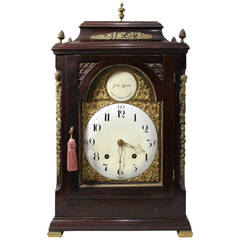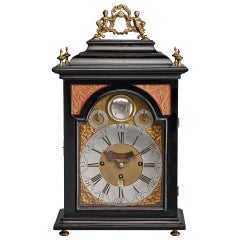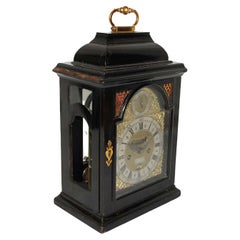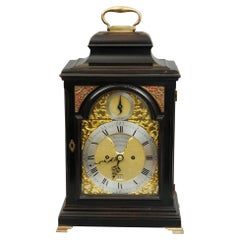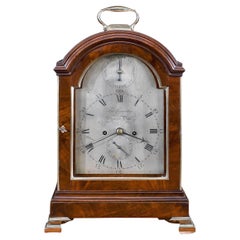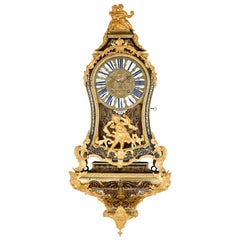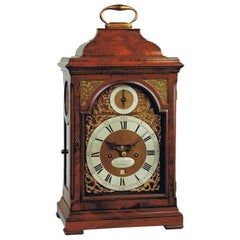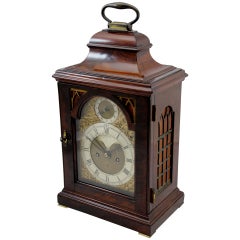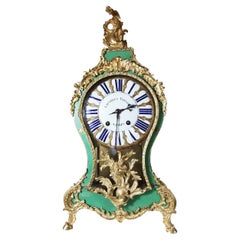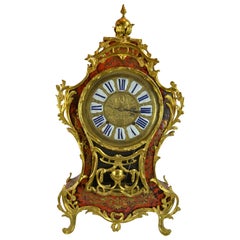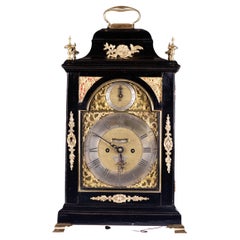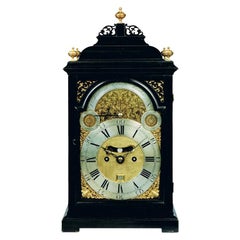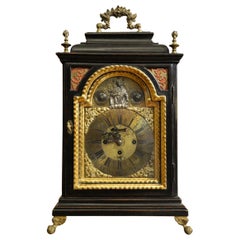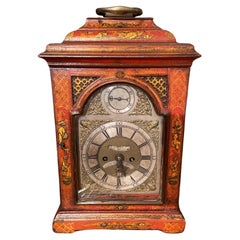18th Century Bracket Clock
Antique Late 18th Century Great Britain (UK) George III Wall Clocks
Antique Mid-18th Century Austrian Baroque Clocks
Brass
Antique Early 18th Century English Mantel Clocks
Wood
Antique Late 18th Century English Mantel Clocks
Wood
Antique Mid-18th Century English Georgian Mantel Clocks
Mahogany
Antique 18th Century French Louis XV Wall Clocks
Brass, Enamel, Ormolu
Antique 18th Century English George II Mantel Clocks
Brass
Antique 18th Century and Earlier English Clocks
Antique 18th Century French Louis XV Mantel Clocks
Metal, Bronze
Antique Late 18th Century French Louis XV Mantel Clocks
Bronze
Antique 18th Century English Georgian Mantel Clocks
Brass
Antique 18th Century English Georgian Mantel Clocks
Brass
Antique Mid-18th Century French Louis XV Wall Clocks
Bronze
Antique Late 18th Century English Georgian Table Clocks and Desk Clocks
Brass, Ormolu
Antique 18th Century Austrian George III Table Clocks and Desk Clocks
Ebony
Antique Late 18th Century English George III Mantel Clocks
Brass
Antique 18th Century English Georgian Table Clocks and Desk Clocks
Brass
Antique Late 18th Century English Georgian Table Clocks and Desk Clocks
Satinwood
Antique 18th Century English George II Table Clocks and Desk Clocks
Wood
Antique Mid-18th Century English George III Mantel Clocks
Walnut
Antique Late 18th Century English Table Clocks and Desk Clocks
Bronze
Antique Early 18th Century French Louis XIV Wall Clocks
Brass, Bronze
Antique Early 18th Century English George II Table Clocks and Desk Clocks
Brass
Antique 18th Century English George III Mantel Clocks
Brass
Recent Sales
Antique 18th Century Austrian Baroque Mantel Clocks
Wood
Antique Early 18th Century British George II Table Clocks and Desk Clocks
Brass
Antique 18th Century and Earlier French Clocks
Antique Early 18th Century English Mantel Clocks
Wood
Antique 18th Century and Earlier Swedish Clocks
Brass
Antique 1770s English George III Mantel Clocks
Mahogany
Antique 1760s English George II Mantel Clocks
Antique Early 18th Century Irish Table Clocks and Desk Clocks
Mahogany
Antique Early 18th Century Dutch Louis XV Mantel Clocks
Bronze
Antique 18th Century and Earlier English Clocks
Fruitwood
Antique 1780s English George III Table Clocks and Desk Clocks
Pearwood
Antique 18th Century and Earlier Swiss Louis XVI Clocks
Ormolu
Antique 18th Century English George III Mantel Clocks
Bronze
Antique Late 18th Century English Neoclassical Mantel Clocks
Ebony
Antique 18th Century British Regency Table Clocks and Desk Clocks
Wood
Antique 18th Century and Earlier English Clocks
Walnut
Antique 18th Century and Earlier English George II Clocks
Lacquer, Wood
Antique Late 18th Century British Clocks
Antique 18th Century and Earlier French Rococo Clocks
Antique 18th Century and Earlier French Louis XV Clocks
Ormolu
Antique 18th Century and Earlier French Louis XV Clocks
Ormolu
Antique 18th Century and Earlier French Régence Clocks
Ormolu
Antique 18th Century and Earlier English George III Clocks
Mahogany
Antique Early 18th Century French Louis XIV Wall Clocks
Bronze
Antique 18th Century French Louis XV Mantel Clocks
Metal
Antique Late 18th Century English Georgian Table Clocks and Desk Clocks
Ebony
Antique Late 18th Century British Georgian Table Clocks and Desk Clocks
Ebony
Antique Mid-18th Century English Chinese Chippendale Mantel Clocks
Antique Mid-18th Century French Louis XV Wall Clocks
Lacquer
Antique Late 18th Century British Table Clocks and Desk Clocks
Ebony
Antique Early 18th Century English George I Table Clocks and Desk Clocks
Ebony
Antique 1790s English George III Mantel Clocks
Brass
Antique Late 18th Century English More Furniture and Collectibles
Antique 1770s English Georgian Table Clocks and Desk Clocks
Hardwood
Antique 1780s Austrian More Clocks
Antique 1790s English More Clocks
Antique 18th Century English More Clocks
Ormolu
Antique 18th Century Dutch George III Table Clocks and Desk Clocks
Brass
Antique Late 18th Century English More Clocks
Antique 18th Century and Earlier English Clocks
Antique Mid-18th Century Swedish Rococo Clocks
Enamel
Antique Late 18th Century English Mantel Clocks
Mahogany
Antique Early 18th Century French Régence Wall Clocks
Bronze
Antique 18th Century English George III More Clocks
Brass, Ormolu
Antique Late 18th Century English George III Mantel Clocks
Satinwood
Antique 18th Century and Earlier English Queen Anne Clocks
Ebony
Antique 18th Century and Earlier George III Clocks
Antique 18th Century French Louis XV Wall Clocks
Brass, Enamel, Ormolu
Antique 18th Century and Earlier French Clocks
Antique Mid-18th Century English George III Table Clocks and Desk Clocks
Cherry
Antique 18th Century and Earlier English Georgian Clocks
Mahogany
Antique Late 18th Century English Georgian More Clocks
Wood
Antique Mid-18th Century English Georgian Table Clocks and Desk Clocks
Brass, Ormolu
Antique 18th Century English Baroque Table Clocks and Desk Clocks
Wood
Antique Mid-18th Century British George III Table Clocks and Desk Clocks
Brass, Enamel, Steel
Antique 18th Century and Earlier English Clocks
Antique Mid-18th Century English George III Table Clocks and Desk Clocks
Mahogany
People Also Browsed
Vintage 1920s American Art Nouveau Sterling Silver
Sterling Silver
Antique 1780s American American Colonial Fireplaces and Mantels
Copper, Wrought Iron
Late 20th Century French Empire Ashtrays
Porcelain
Early 2000s Italian Queen Anne Fireplaces and Mantels
Marble
2010s German Black Forest Glass
Crystal
Antique 1810s French Mantel Clocks
Belgian Black Marble, Bronze, Ormolu
Antique Late 19th Century French Louis XVI Vitrines
Mahogany
Early 2000s Italian Queen Anne Fireplaces and Mantels
Marble
2010s British Louis XVI Sofas
Beech
Antique Late 19th Century German Black Forest Clocks
Walnut
Vintage 1950s Danish Scandinavian Modern Vases
Porcelain
Antique Early 19th Century French Louis XIV Fireplaces and Mantels
Marble
20th Century French Hollywood Regency Barware
Crystal
Early 20th Century British Neoclassical Dinner Plates
Paste, Porcelain
Antique Late 19th Century French Belle Époque Table Lamps
Granite, Bronze, Ormolu
Antique 19th Century French Napoleon III Crystal Serveware
Crystal, Ormolu
18th Century Bracket Clock For Sale on 1stDibs
How Much is a 18th Century Bracket Clock?
Finding the Right Clocks for You
A sophisticated clock design, whether it’s a desk clock, mantel clock or large wall clock for your living room, is a decorative object to be admired in your home as much as it is a necessary functional element. This is part of the reason clocks make such superb collectibles. Given the versatility of these treasured fixtures — they’ve long been made in a range of shapes, sizes and styles — a clock can prove integral to your own particular interior decor.
Antique and vintage clocks can whisk us back to the 18th and 19th centuries. When most people think of antique clocks, they imagine an Art Deco Bakelite tabletop clock or wall clock, named for the revolutionary synthetic plastic, Bakelite, of which they’re made, or a stately antique grandfather clock. But the art of clock-making goes way back, transcending continents and encompassing an entire range of design styles and technologies. In short, there are many kinds of clocks depending on your needs.
A variety of wall clocks can be found on 1stDibs. A large antique hand-carved walnut wall clock is best suited to a big room and a flat background given what will likely be outwardly sculptural features, while Georgian grandfather clocks, or longcase clocks, will help welcome rainswept guests into your entryway or foyer. An interactive cuckoo clock, large or small, is guaranteed to bring outsize personality to your living room or dining room. For conversation pieces of a similar breed, mid-century modern enthusiasts go for the curious Ball clock, the first of more than 150 clock models conceived in the studio of legendary architect and designer George Nelson.
Minimalist contemporary clocks and books pair nicely on a shelf, but an eye-catching vintage mantel clock can add balance to your home library while drawing attention to your art and design books and other decorative objects. Ormolu clocks dating from the Louis XVI period, designed in the neoclassical style, are often profusely ornate, featuring architectural flourishes and rich naturalistic details. Rococo-style mantel clocks of Meissen porcelain or porcelain originating from manufacturers in cities such as Limoges, France, during the 18th and 19th centuries, exude an air of imperial elegance on your shelves or side tables and can help give your desk a 19th-century upgrade.
On 1stDibs, find a range of extraordinary antique and vintage clocks today.
- 1stDibs ExpertNovember 13, 2024To identify 18th-century furniture, you can research your piece in the context of the prevailing styles of the period or consult a certified appraiser or experienced antique dealer. To identify your item on your own, look over it for maker's marks, such as carvings, stamps, brands and labels. Researching the marking can help you determine the maker of your piece, and from there, you can search further to learn more about your particular item. Without a maker's mark, the best approach is to consider the characteristics of the dominant furniture styles during the 18th century. In England, these included William and Mary, Queen Anne, Georgian, Chippendale, Hepplewhite and Sheraton. Some French furniture styles of the 1700s include Louis XV, Louis XVI and Régence. Find a diverse assortment of 18th-century furniture on 1stDibs.
- 1stDibs ExpertApril 5, 2022Yes, wedding rings have a long history, stretching back to ancient Egypt. The first diamond engagement ring was created in 1477 by Archduke Maximillian of Austria. Browse a wide array of vintage and contemporary wedding rings on 1stDibs.
- 1stDibs ExpertApril 5, 2022In the 18th century, art changed in style from Baroque to Rococo and Neoclassicism. Art became more ornamented and idealized during the Rococo period and then shifted toward a style that emulated the artwork of ancient Greece and Rome near the end of the century. You’ll find a variety of fine art on 1stDibs.
- 1stDibs ExpertApril 5, 2022One way to check if your brass candlesticks are from the 18th century is to look for the two seams running lengthwise on either side. This is from when the candlestick was molded in two halves and then soldered together. You’ll find a variety of candlesticks of all shapes and sizes from some of the top sellers on 1stDibs.
- 1stDibs ExpertJanuary 10, 2025The individuals considered the Big Three of 18th-century cartoons are William Hogarth, James Gillray and George Cruikshank. Although the 18th century saw a widespread increase in illustrations in newspapers, these three illustrators were particularly well-known for their work. Hogarth's work was extremely diverse, ranging from serious, realistic paintings and portraits to satirical and moralistic illustrations filled with symbolism. A British caricaturist, Gillray is remembered today for his artworks representing political and social satires, like his political cartoons against George III of England. Despite being a prolific caricaturist, Cruikshank is now most famous for illustrating the works of Charles Dickens. On 1stDibs, find a wide variety of illustrations.
- 1stDibs ExpertApril 5, 2022At the end of the 17th century, Europe went into a frenzy over porcelain. Asian porcelain was highly sought after, and spurred the foundation of the Meissen factory in France, where hard porcelain went on to be made. You’ll find a large collection of porcelain pieces from many of the world’s top sellers on 1stDibs.
Read More
How a Craving for Color Revolutionized Glass
After synthetic dyes changed fashion, home goods and printed matter, it was only a matter of time till glass caught up.
Kazuyo Sejima’s Flowering Tree Blooms Year-Round
The brilliantly simple design turns a modest bouquet into a major statement.
He Wrote ‘Oedipus Rex,’ but Do You Know What He Looked Like?
The Greek tragedian is said to have been handsome in his day.
Cigar Culture Was Once the Peak of Masculinity. Now, It’s a Compelling Curiosity
Even for those who don’t indulge, elegant smoking accessories and audacious art portraying cigar enthusiasts hold a nostalgic allure.
African Travel Plans on Hold? This Ardmore Leopard Vase Brings the Beauty of the Savanna to You
It’s an excellent example of the sought-after ceramics coming out of South Africa’s KwaZulu-Natal province.
With a High-Tech Flagship and Cool Collabs, Lladró Is Breaking the Mold for Porcelain Production
Thanks to its new leadership, the Spanish maker of figurines, busts and lighting is on a mission to update the art of porcelain for the 21st century.
Zoë Powell’s Magnolia 05 Vessel Is Handmade from Clay She Unearthed Herself
The free-form stoneware piece is inspired by the magnolia tree and its associations with home.
8 Ways to Breathe New Life into a Space with Plants
The pair behind the Instagram account @houseplantclub share their tips for making any room of the house gloriously green.
